Non-Toxic Air Freshener Guide
Written by:
Maia James
03/16/2024
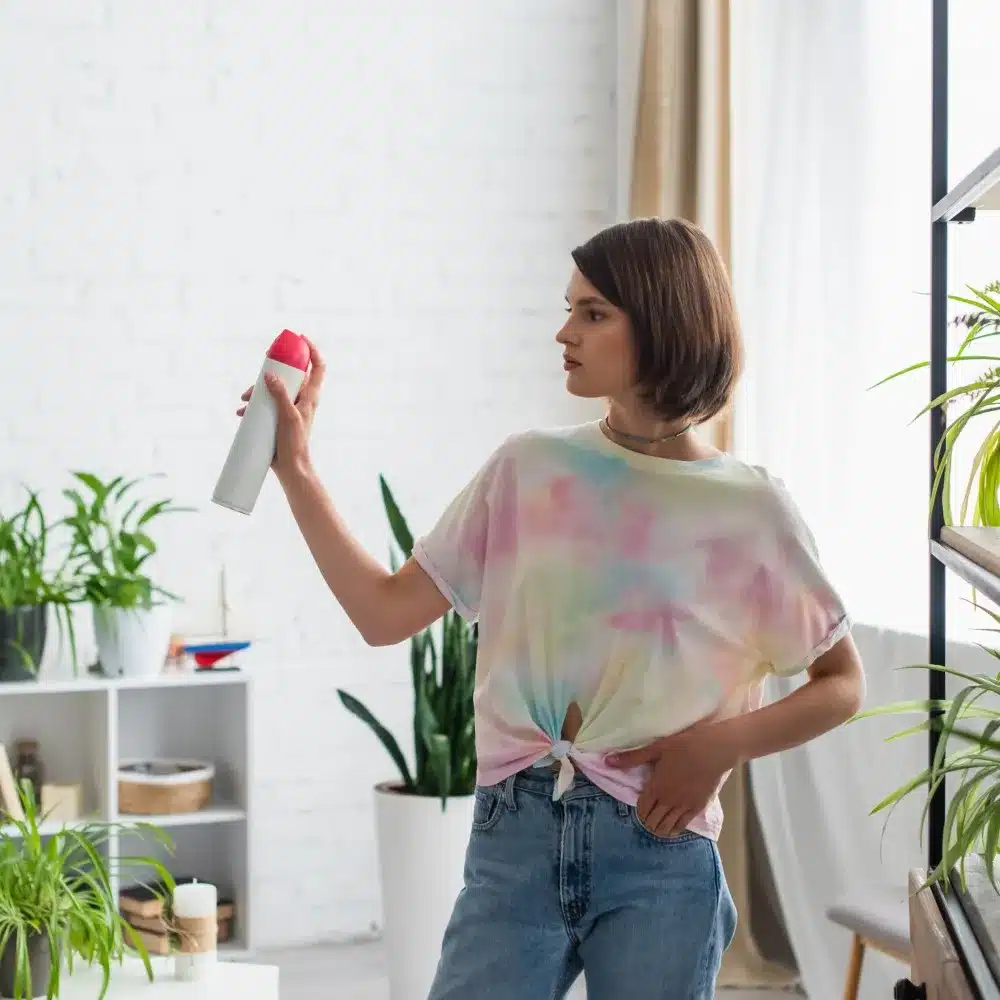
Updated: 04/04/2024
Looking for a different guide? Browse them all HERE.
When I started dating my now-husband, I loved that his bachelor pad always smelled so nice. This was thanks to a prominent Glade plug-in in his entryway. Once I learned about what was in that air freshener, I promptly unplugged it. This meant that our apartment began smelling like whatever we’d last cooked. It was wonderful on the rare occasion when I baked an apple crisp, and less awesome after the more common meal of pan-fried salmon and steamed broccoli. So, I began the hunt for a non-toxic, natural air freshener.
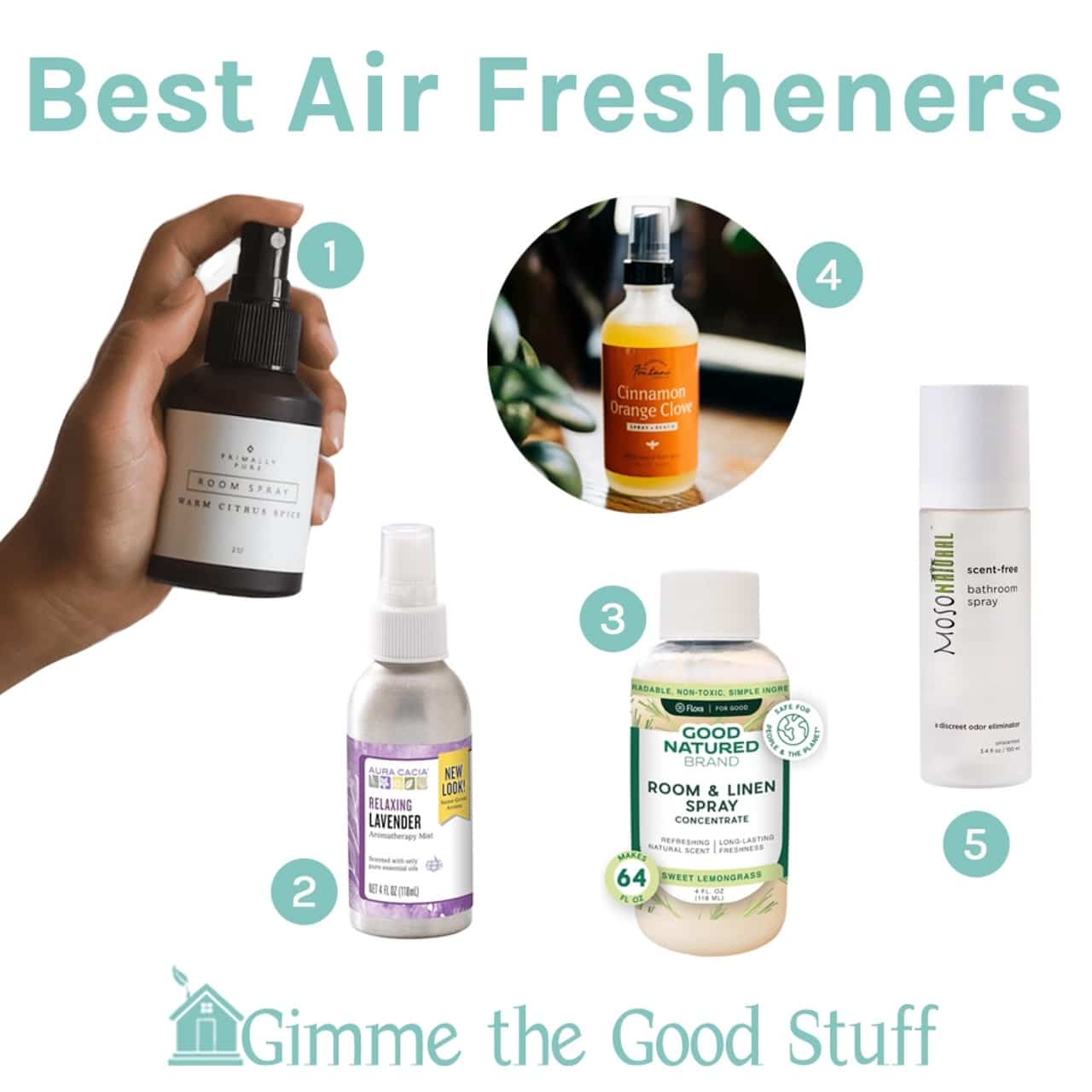
1. Primally Pure / 2. Aura Cacia / 3. Fontana Room Spray / 4. Good Natured / 5. Moso
A Brief History of Air Fresheners
The use of household air fresheners, in one form or another, has been around for thousands of years.
Incense, one of the most ancient forms of air fresheners, is burned so that the smoke can mask other, less pleasant odors. Most modern air fresheners employ the same method (masking).
But unlike the burning of incense, most air fresheners disperse masking agents in other ways, and with a far more sophisticated use of chemistry. (By the way, just because we’ve been burning incense for many centuries does not mean it’s a great idea. Burnt airborne particulates, from incense to cigarettes to auto exhaust, are always bad to inhale, no matter the form.)
Since the 1940s, air freshener manufacturers have blended various chemical agents and tinkered with a range of dispersal techniques to market products that don’t involve burning. This might seem like a step in the right direction, but the chemical agents used are hugely problematic.
My Top Pick For Best Natural Air Freshener
Fontana Essential Oil Room Spray
This 100% natural essential oil room spray is a safe way to impart a beautiful scent into your home.
Cost per ounce: $9.99
Why Modern Air Fresheners Stink
Modern chemistry has shown us that certain chemical agents, when atomized and inhaled, are capable of blocking our smell receptors. This blunts our ability to detect odor. This is how many air fresheners work.
Other air fresheners coat our nasal passages with an oily film, and many still just cover up the original odor with better-smelling scents.
A minority of air fresheners actually break down the offensive odor, and even those ones generally contain a heavy dose of unsafe chemicals.
Let’s look more specifically at what is in most spray or plug-in air fresheners.
What’s Wrong with Conventional Air Fresheners?
A regular run-of-the-mill air freshener will probably contain at least one of the following toxic ingredients:
- Phthalates. Synthetic fragrances usually contain phthalates, and most of us know that phthalates in air fresheners and other products are bad. Phthalates are linked to early puberty, autism, obesity, and birth defects. You often won’t see “phthalate” on a label; it’ll just say “fragrance” or perhaps “parfum.”
- PEG-40. The Environmental Working Group considers this polymer to be moderately hazardous to human health.
- 1,4-dichlorobenzene (1,4-DCB). 1,4-DCB is reasonably anticipated to a human carcinogen and has been shown to cause kidney and testicular cancer in rats.
Air fresheners may also contain some really gross chemicals that won’t show up on the label. A 2007 study tested 74 air freshening products and measured the concentration of VOCs in the air after use. They reported that a total of more than 350 different chemicals and allergens were detected, including (but not limited to!) benzene, formaldehyde, styrene, and phthalates. Spray bottles (aerosol) cause additional health risks due to ingredients used as propellants, such as butane and propane.
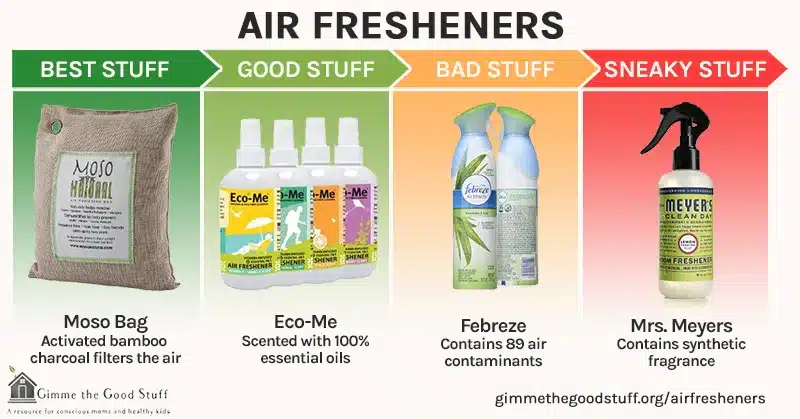
What About Non-Toxic Candles?
The majority of scented candles are toxic. Even soy-based candles aren’t truly non-toxic or earth friendly. Soy wax can still be processed with petroleum-based chemicals, which isn’t always disclosed.
We have found one brand of candles that are truly toxin-free. Fontana Candle products are made from natural beeswax and essential oils. These candles smell amazing and are completely natural. Even the wick is non-toxic!
Each of the ingredients used in Fontanta’s candle making process is hand-selected, including beeswax, coconut oil, natural essential oils, and wooden wicks. You won’t find any petroleum byproducts, stabilizers, fragrance oils, or harmful dyes in these candles Fontana candles are now the first to be MADE SAFE® certified and have always been certified cruelty-free by the Leaping Bunny Program.
-
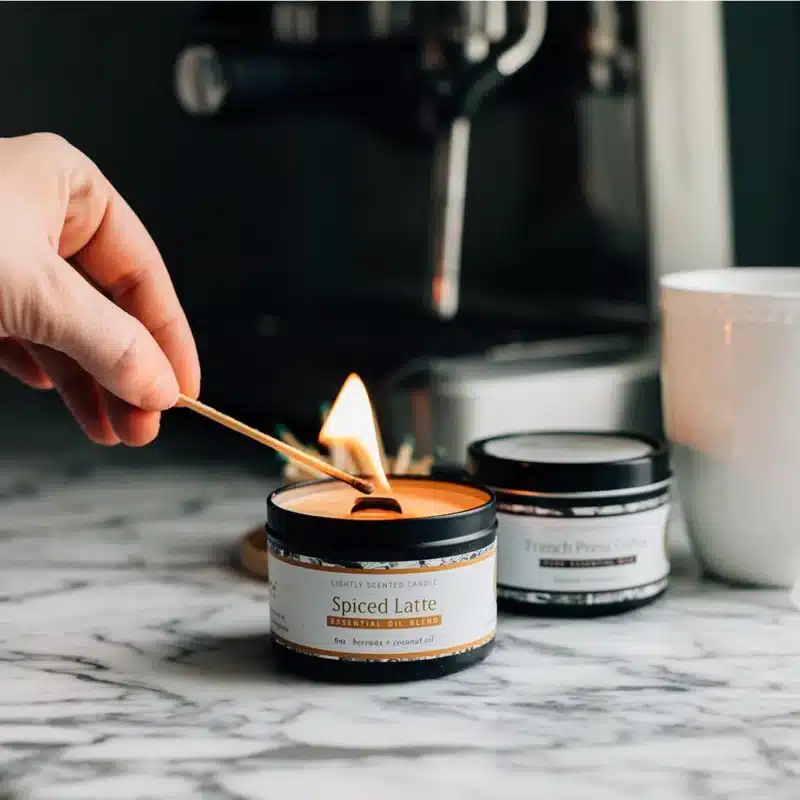 Fontana Candles Essentials Kit$200.00
Fontana Candles Essentials Kit$200.00 -
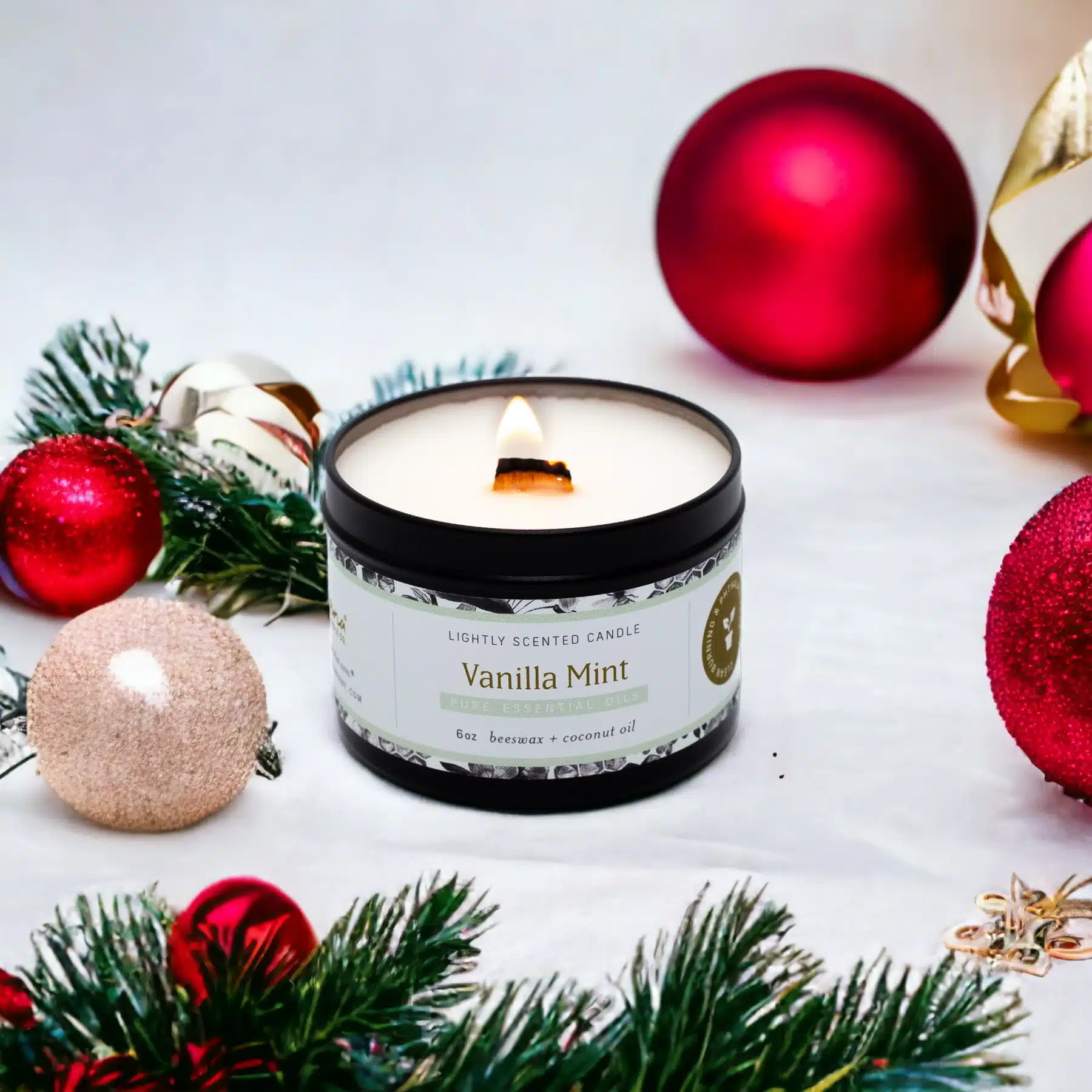
How to Find a Natural Air Freshener: Which Air Fresheners Are Safe?
Rather than masking odors with other, more potent odors, or disabling your sense of smell altogether, there are ways to absorb unwanted odors. Sodium carbonate (otherwise known as baking soda) has been safely used as an odor sponge for generations with no known ill effects. There are also ways to employ specific types of charcoal products to scrub unwanted odors from indoor air.
When it comes to spray air fresheners, the good news is that there are regulations regarding what can and cannot go into them. The bad news is that there are gaping loopholes in these regulations, the most obvious of which is “trade secrets.” This allows companies to refuse to name all the ingredients in an air freshener. Without this disclosure, it’s very challenging to figure out if your air freshener is toxic just by looking at the label.
We’ve done the research for you here, so read on for which natural air fresheners are truly safe and effective.
Good Stuff
Aura Cacia Natural Air Freshener
Aura Cacia has a demonstrated committment to product safety as well as sustainability. Their spritzer air freshener is made from essential oils and water and also uses no propellants.
Aura Cacia also makes a plug-in room diffuser that you can use with their selection of essential oils.
Natural Air Freshener Lavender Ingredients: Water (Aqua), Lavandula Angustifolia (Lavender) Oil, Lactobacillus Ferment, Benzoic Acid, Lavandula Intermedia (Lavandin) Oil, Lavandula Latifolia (Spike Lavender) Oil, Sodium Hydroxide, Citric Acid.
Cost per ounce: $1.62
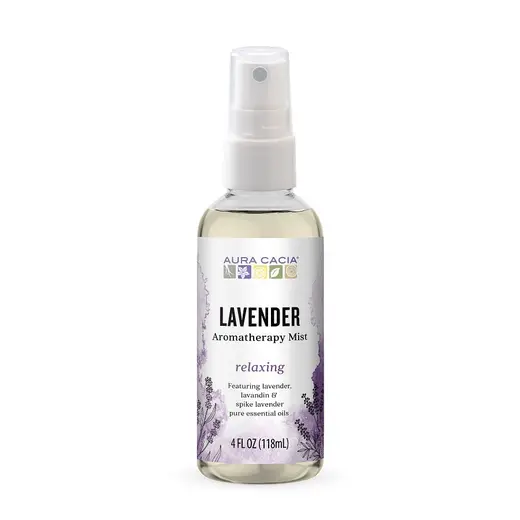
Fontana Essential Oil Room Spray
This home spray is my favorite in terms of the scents. It’s entirely safe and comprised of only essential oils.
Lavender Ingredients: Hammamelis Virginiana (Witch Hazel), distilled water, LAVENDULA ANGUSTIFOLIA (lavender), PELARGONIUM GRAVEOLENS (geranium), CITRUS SINENSIS (sweet orange)
Cost per ounce: $9.99
Fontana Wax Melts Air Freshener
If you want something that’s 100% natural but best mimics a conventional plug-in air freshener, we recommend the Fontana Wax Melts. These are made with only natural and non-toxic ingredients like coconut oil and beeswax.
You can choose from a variety of essential oils scents, including vanilla, lavender, and citrus peel & pine. All wax melts are made with ingredients that have passed MADE SAFE screenings. To use, you’ll also need to purchase a wax warmer. The Fontana wax melt pucks burn for 20 to 25 hours.
Sample Ingredients: Cocus Nucifera (coconut oil), Apis Mellifeca (beeswax), Aromatic Vanilla Extract: Natural Triethyl Citrate, Vanilla Planifolia Fruit Extract, MENTHA PIPERITA (steam distilled peppermint oil), MENTHA SPICATA (steam distilled spearmint oil)
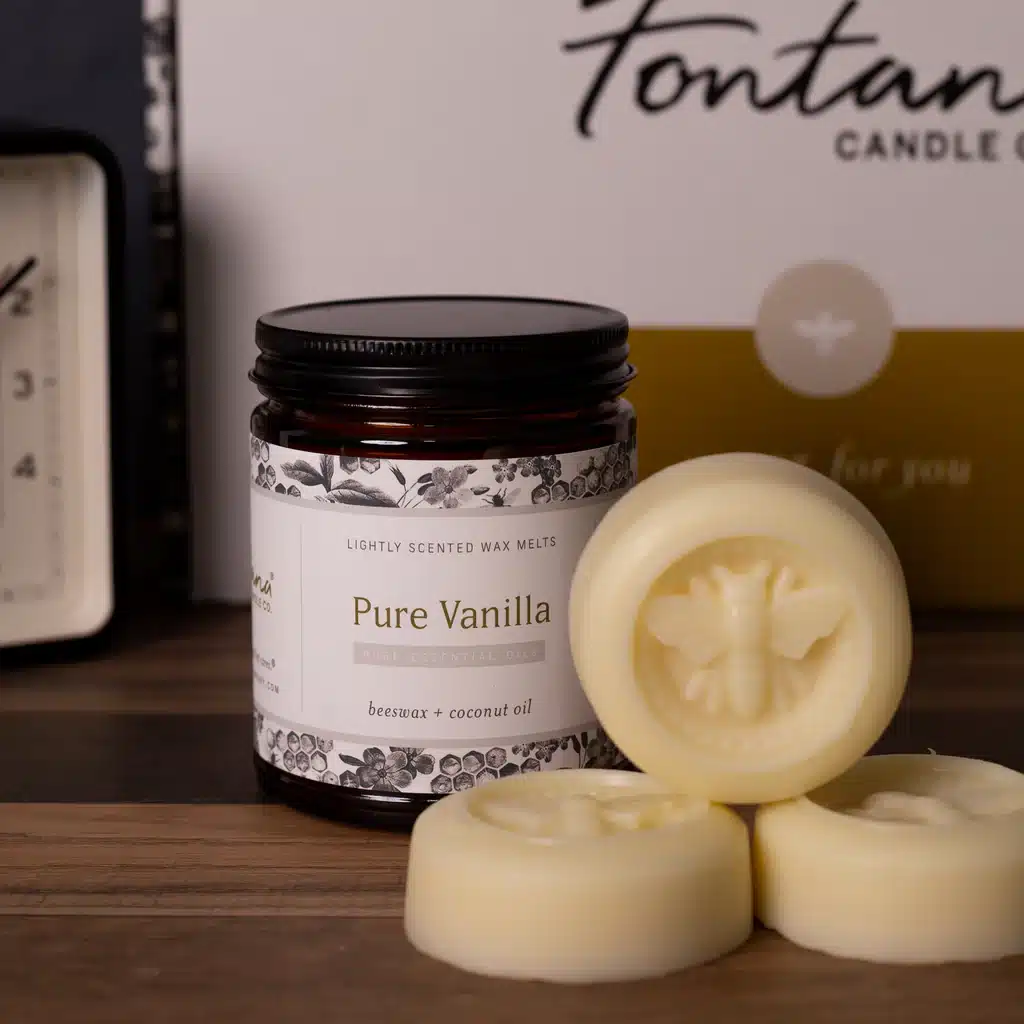
Good Natured Brand Air Freshener Spray or Concentrate
Good Natured Brand Room & Linen Spray or Concentrate has a lingering sweet lemongrass scent that freshens the air with only natural essential oils. You can purchase the pre-mixed spray bottle to start. Then, if you want to save money (and bottles!), you can order the refill concentrate. You mix 1 ounce of concentrate with 15 ounces of water to make one bottle of spray.
Ingredients: Water, Decyl Glucoside, Cymbopogon Schoenanthus (Lemongrass) Oil.
Cost per ounce: $0.22
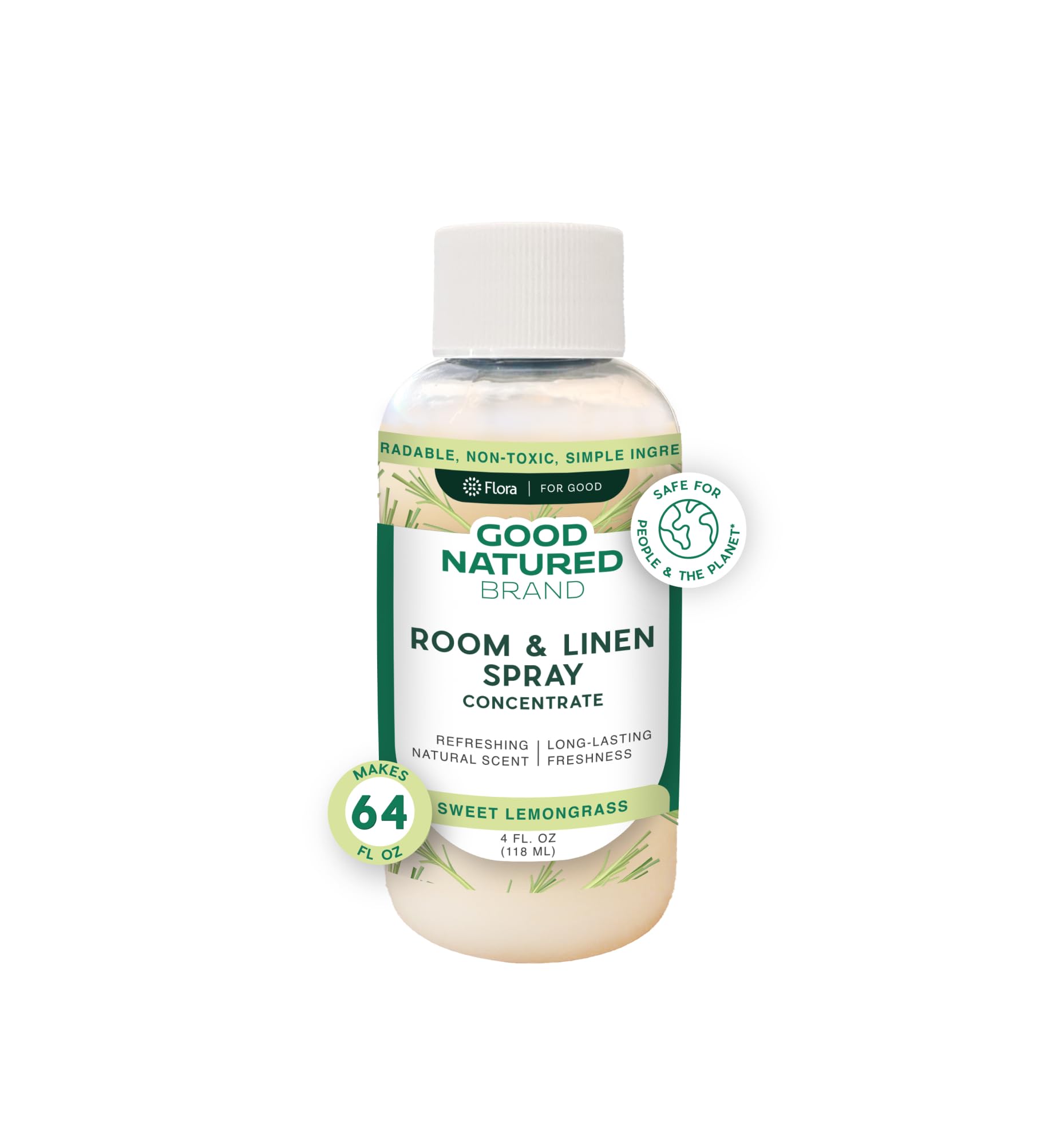
Moso Natural Air Freshener/Purifier
While these charcoal bags are different from a spray air fresheners, they are surprisingly effective at reducing indoor odors. Moso bags contain activated bamboo charcoal, which serves as a filtering agent (as opposed to a masking agent). The great thing about most filtering agents is that they not only remove unwanted odors, but they also scrub the air of some of the nasties that may be floating around your home—things like formaldehyde, ammonia, benzene, chloroform gases, and bacteria/allergens. After a couple of years of use, simply throw the charcoal on your garden–it’s 100% biodegradable. The bags range in size, and will cost between $10 and $22.
Moso Natural Unscented Air Freshener Spray
This is a fast and scent-free solution for bathrooms, garbage areas, and other areas prone to odors. This powerful formula uses probiotics that actively target and destroy odor-causing molecules, without the use of overbearing fragrance.
Ingredients: Water, Proprietary Blend Of Non-GMO Probiotics, Sodium Citrate, Potassium Phosphate, EPA Safer Choice Ordenone, Plant-Based Surfactants
Cost per ounce: $3.80
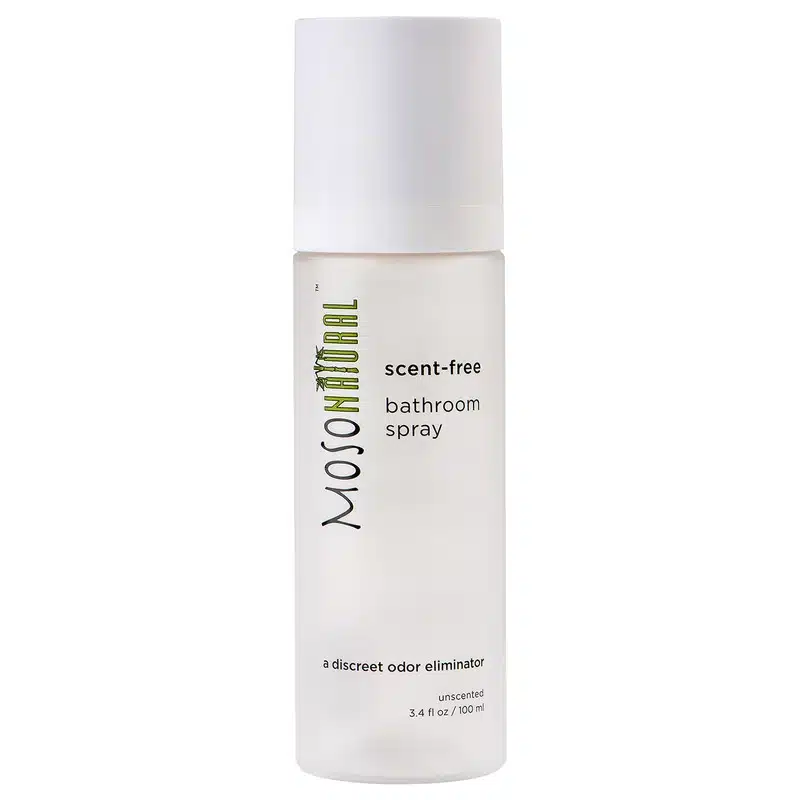
Poofy Organics Natural Air Freshener
Poofy’s aromatherapy blend contains nothing concerning, and imparts the room with a pleasantly herbal kind of fragrance.
Ingredients: Distilled water, Organic Aloe Juice, Organic Saponified Coconut oil, Organic Saponified Shea butter, Organic Saponified Olive Oil, Organic Saponified Sunflower oil, Organic Saponified Jojoba Oil, Organic Glycerin (coconut), Organic Guar Gum, Organic Calendula extract, Rosemary Extract, Organic Lemon (Citrus Medica Limonum) Essential Oil, Organic Lime (Citrus Aurantifolia) Essential Oil, Organic Orange (Citrus Aurantium dulcis) Essential Oil.
Discount code: MAIAJAMES for 10% off
Cost per use: $1.12
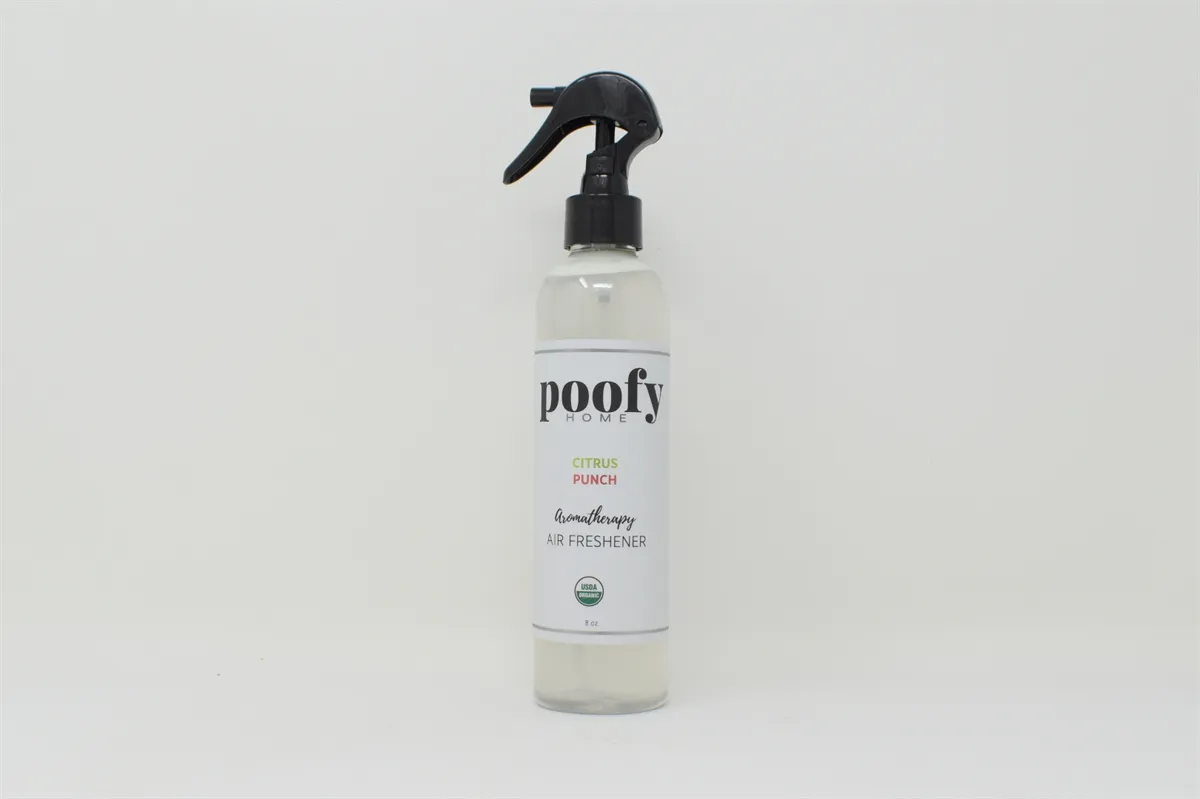
Primally Pure Air Freshener Room Spray
Primally Pure Room Spray comes in seasonal scents like warm citrus spice to purify your home. The spray smells extra luxurious to me–and it makes a beautiful gift. It contains a blend of wildcrafted botanicals with antibacterial, antiviral, and antiseptic properties to help purify the air in addition to imparting a scent. You can spray the air freshener directly into the air or onto linens, couches, and curtains, too
Sample Ingredients: Distilled water, grape alcohol*, essential oils of cardamom*, wildcrafted orange, blood orange*, cinnamon bark, wildcrafted cacao, wildcrafted ocotea, wildcrafted manuka and roman chamomile*
Cost per ounce: $16
Use code: GIMMETHEGOODSTUF10 for 10% off sitewide.
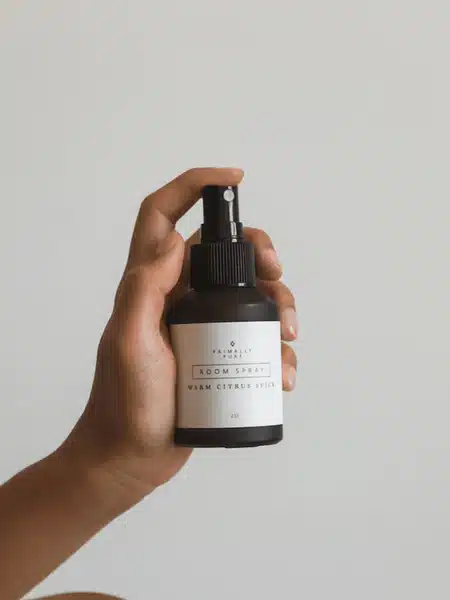
Bad Stuff
Glade PlugIns are some of the top selling air fresheners in the United States. SC Johnson moves well over 20 million units of these guys a year, which is scary when you know what’s in them. PlugIn units contain a small heating element, which heats the “scented oils” (not to be confused with actual essential oils), and causes them to disperse into the air. Using the trade secret loophole, Glade will not release their entire ingredient list. We do know that PlugIns have parabens and phthalates, which is enough to earn them a Bad Stuff designation.
Lysol Neutra Air Sanitizer evokes a feeling of cleanliness and safety, thanks to the use of the word “sanitizer.” Not so much. Besides including the pesticide dimethyl benzyl ammonium saccharinate, this product comes in an aerosol can and uses butane and propane as propellants. It’s not good to breathe any of these volatile gasses, and don’t light a match around them. Lysol Neutra also contains trace levels of phthalates. Lysol earns extra demerits for the “New Moms” section of their website, where they promote cleaning and disinfecting with Lysol products!
Febreze is one of the only air fresheners that actually neutralizes odors (in addition to masking them with a big burst of fragrance). Think this makes Febreze Good Stuff? Nope. EWG examined Febreze Air Effects (Hawaiian Aloha) and found air contaminants associated with asthma, allergies, and environmental toxicity.
Sneaky Stuff
Caldrea Linen and Room Spray is advertised as follows: “ This safe and versatile essential oil air freshener creates a signature scent.” “Safe” is a stretch, considering that among the ingredients are benzisothiazolinone, which irritates skin and is linked to cancer, and methylisothiazolinone, which carries with it immune system and allergy concerns.
Mrs. Meyers Air Freshener claims to be earth-friendly, but contains synthetic fragrance, and Mrs. Meyers doesn’t divulge what specific chemicals make up the scent. On top of that, this product contains PEG-40, which is neither natural nor non-toxic.
You’ll find Citrus Magic air fresheners in most health food stores. The most recent study I found (which is from 2007) showed that Citrus Magic contained trace amounts of phthalates. I have not been able to confirm whether or not this has been remedied. The label of their solid air freshener still just reads: “fragrance.”
Safe Air Fresheners That Also Clean the Air
Some air fresheners use essential oils that help purify the air. But to truly CLEAN the air, you need an air filter. Indoor air doesn’t easily mix with fresh air, allowing contaminants to accumulate.
Using an air filter can help remove contaminants from the air rather than just masking smells. Toxins air filters can help remove from indoor air include:
- Particulates, like dust, smoke, mold spores, pollen, diesel exhaust, flame-retardants, bacteria, and viruses.
- VOCs, like formaldehyde, acetone, benzene, butanol, carbon disulfide, ethanol, terpenes, toluene, and more.
The combination of air-tight homes and toxic agents (such as cleaning products and off-gassing furniture and carpets) is a real health risk, especially when we consider how much of our lives we spend indoors.
To choose the best air filter for your home, check out our Air Filters Safe Product Guide. And here are the three that I have in my home:
-

-
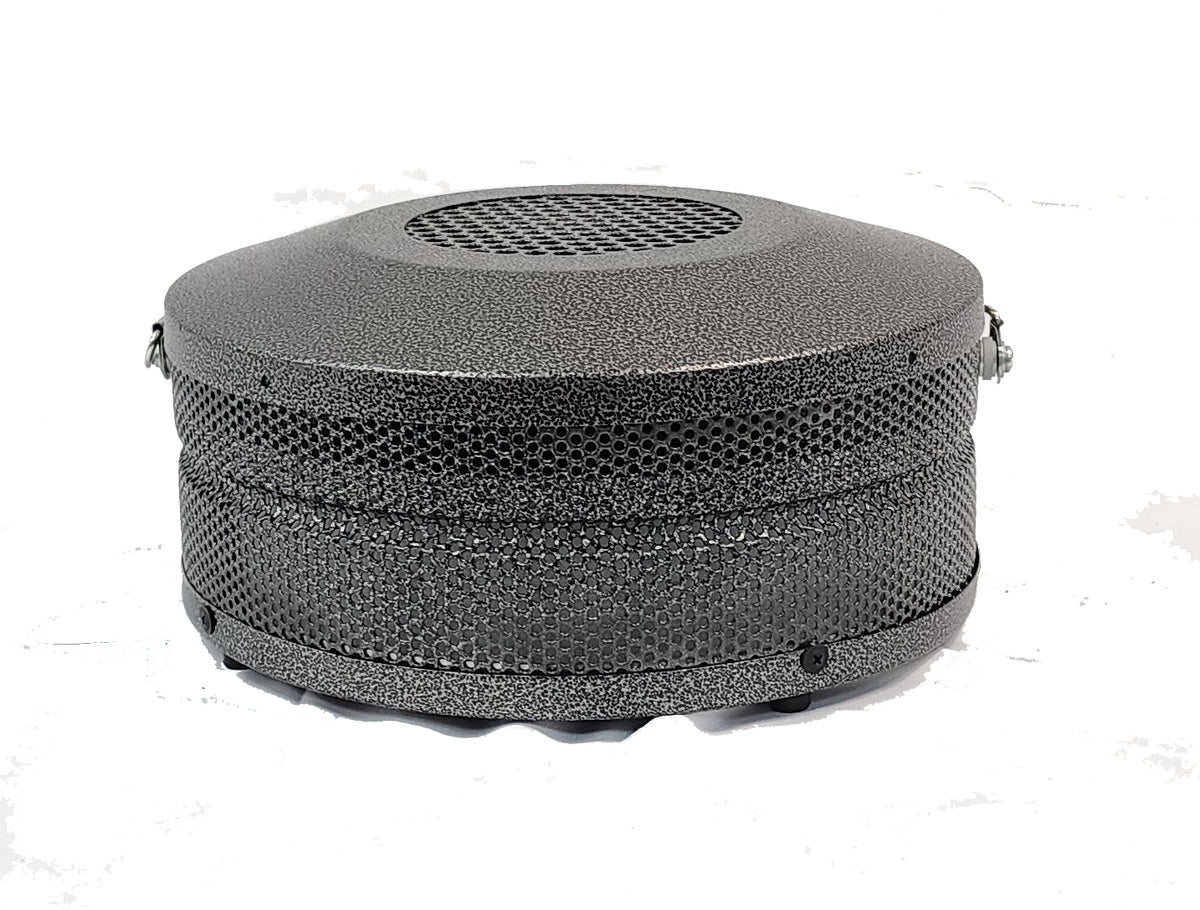 Product on saleAllerAir MobileAir Plus – Desktop Air Purifier – Carbon & HEPA$299.00 – $329.00
Product on saleAllerAir MobileAir Plus – Desktop Air Purifier – Carbon & HEPA$299.00 – $329.00 -
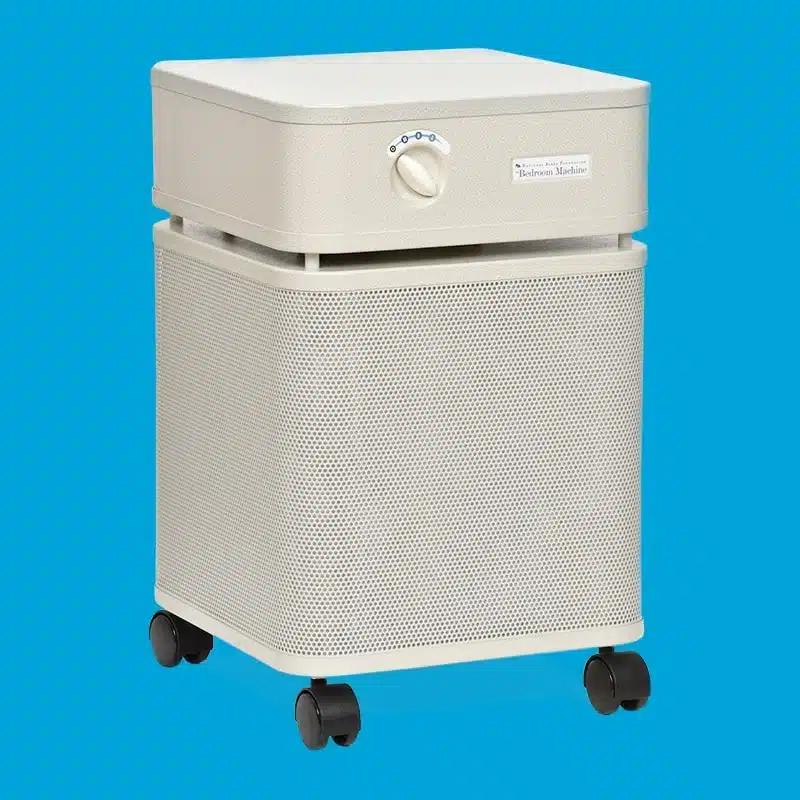
Make Your Own Natural Air Fresheners
Sometimes I will make the effort to simmer spices on the stovetop to make our house smell nice. Clove and orange peels, for instance, lend a really nice aroma to my apartment. Just be sure to keep enough water in the pot so that your homemade potpourri doesn’t burn.
I look forward to your comments!
Stay sane,


Maia, Founder & CEO
Note: This article contains affiliate links or sponsored content, which means that if you make a purchase, we may earn a commission. We only recommend products that meet our strict standards for non-toxicity and that we use (or want to use!) ourselves. Thank you so much for supporting the brands that make Good Stuff!
Enjoying this guide?
Join 60K families who rely on our free guides on everything from milk to mattresses! Sign up to get $5 off your first order, access to our ultimate Clean Products Cheat Sheet, and ongoing exclusive access to coupon codes and promotions. Our weekly newsletter is filled with well researched tips and tricks to live a toxin-free lifestyle.
Related Posts
Start Here: 5 Crucial Steps to Decrease Toxins in Your Home
42 Ways to Have a Healthy 2024
What is Prop 65?
Best Pitcher Water Filters
-
Hi. Can you tell me about Pura? They advertise as non toxic eco friendly and safe for pets and kids. Just wanted to get your take. Thanks!
-
Have you heard of Pura diffuser and their scents? It’s supposed to be safe for environment, pets and kids. Wondering your thoughts on it.
-
My understanding is the Scent Fill 100% natural oil air wick plug in is non toxic is this a good room deodorizer to use.
-
I had made a request which may have been incorrect! I had spoken to some people I reside with this morning ( text message from 347-931-4200) and said in paraphrase ” don’t light incense in the hallways and other rooms as people may pass out, but light it in the bathroom for shitting. I asked to spray the hallways and rooms with Lysol neutra air.” I had in a questionnaire on social media asked to smoke out the subway tunnels than spray oil air freshener to capture the smoke and drag it to the ground and install indoor breathing plants. I would like to know if I should retract that statement also, as the subway tunnels get moist sometimes. I spoke also to folk about putting scented oil on their nose holes instead of smoking, but that maybe extraordinarily strong also. I am trying to find out about ECO-ME with a natural nonflammable propellants and nozzle combination that can spray a strong enough mist to capture building spaces properly.
My contact info
Ricardo George Hamilton jr.
1060 Walton avenue Bronx,NYC,NY 10452 between 165st and 166st
347-931-4200 Cell Phone 718-293-3136 House number
Bronx
(soul embryo)8 to 9(blood clot cell) months before 01/14/1990( date separated from mother)
***-**-1071 Last 4 of my social security number
NY010732345 My workforce 1 number I have multiple job interviews with them which need to be documented!
I have help from America Works also!
I am getting a review of my case management with Yaritza Gomez-Nacht my ID # 722675099 and her number is 646-265-0687 from Empire blue cross blue shield and
I left a message and spoke about working with Michelle Kirk, (Administrative Specialist Trainee 2, SNAP Policy/Field Operations Bureau, Employment and Income Support Programs) -
What is the consensus on the new Pura plug ins?
-
I was wondering the same
Thing. They are supposed to be safe for environment, pets, and kids. Non toxic with no chemicals.
-
-
I know the Citrus Magic air fresheners were reformulated years ago (2010?) and don’t contain phthalates. Someone really needs to update this information!!
-
Hello,
I was reading you webpage, and it seems like the “Air Fresheners” DIY link didn’t work. I am wondering if you had a recommendation to create a non-toxic room spray, as I have a newborn and want to make sure it’s safe!
Thank you
-
Hello Maia,
Thank you for your site. I have been using the ORGANIC Citrus Magic Air Freshener for a few years now. I planned to buy more but I am unable to locate the organic item. I googled the Citrus Magic company and found your website.
You say that the latest research that you found on Citrus Magic was from 2007. As you say, this product is sold in health food stores and such stores as Whole Foods but as you also say, that doesn’t guarantee that the product is not toxic.
My question is do you have any more recent information on Citrus Magic, especially on their organic freshener.
Finally, I have a question about plug-in essential oil diffusers – many months ago, I planned on buying a diffuser. In preparation, I bought some high quality essential oils. Then, my research indicated that the plug-in essentila oil diffusers are not completely safe. I have already forgotten the reason(s) why. So, I never bought a diffuser. What do you think about plug-in diffusers.
Thank you. I look forward to reading your answers.
Annie -
may
-
may
-
april
-
well, even essential oils are bad now. so we are all out of luck. https://www.wusa9.com/article/news/the-hidden-dangers-of-essential-oils/65-efb594b4-dc08-46d0-8ec3-a64251b8df45
-
My go to is to diffuse great 100% pure therapeutic grade essential oils. Not only do they make it smell good but they are good for you.
-
Just make sure they are unadulterated oils. There are so many cheap oils that aren’t good for you.
-
-
april
-
april
-
Hi Maia,
We would love to send you some samples of our London Love Air Sanitizer, So you can test it out.
Clinically proven to eliminate offensive odors rather than masking them, eliminates smoke odors, kills airborne germs and bacteria.
Controllable with immediate results.
Great for pet odors too
Convenient size
https://www.newportbutane.com/london-love/air-sanitizer
Dm us your contact info 😉Thanks for sharing
Jane @ Newport Butane -
Hi Maia,
While reading your Non Toxic Air Freshener Guide, I noticed that you did not have a natural alternative to the plug in type air fresheners.
I work for a small, family owned business in Oldsmar Florida called Scent fill. We sell all natural 100% essential oil plug in refills that are universal fit to Glade and Air Wick warmers. Our 100% all natural scents are certified 100% natural and have INCI certification. We are the first product on the market in the 100% all natural arena.
Scent Fill started on a belief that there was a better way to bring you high quality, universal fit refills. Our refills are made with more essential oils or all natural ingredients than store bought refills with a selection featuring 100% all natural options. We also recognized consumer confusion over refill compatibility between various plug in warmers and made a single universal fit bottle that fits major brand plug in warmers such as Glade and Air Wick.
I have included a link below to our website:
https://scentfill.com/collections/all-natural
I invite you to take a look and tell me what you think. I’m hoping you will be as excited as I was to find an all natural plug in home fragrance. I loved Scent Fill so much, I became an employee!
We have an affiliate marketing program and would like to share this information with you as well. Let me know, I would love for you to try our products for yourself.
Please feel free to reach out with any questions or concerns.
Thanks so much for your time and consideration,
Lisa Hanna
Scent Fill-
Heating essential oils are bad to inhale. I can’t find a wayvto put it into the air that is done in a healthy way .
-
-
Young Living is a trusted essential oil company that has pure oils with no fillers, solvents or chemicals. They do numerous tests and have a seed to seal guarantee. The company is a lifestyle company that cares about health and wellness and what goes in and on our bodies. They have safe and clean products like vitamins, baby line, kids line, makeup, oils, fitness, skincare, personal products, sunscreen, insect repellent and so much more!! It is an amazing company where we help people ditch and switch to safer and teach them about health and wellness. 🙂
-
I am in search for something to replace wallflowers from yankee or bath and body works.
What are your comments for essential oil diffusers (non heat, non water) from https://organicaromas.com/ this company.
They are not cheap so I wanted to be sure before I make a purchase like that. -
Hello,
Thank you for your article!
What about air filtering devices such as air filterer with HEPA filters? Would they be worth investing?Thank you,
-
From what I am reading most essential oils are toxic.
-
I have a Home Lab VOC monitor in our home (Debra Lynn Dadd). When we used organic lavender essential oils in a diffuser, the VOCs in my son’s room went sky high. Essential oils are not necessarily nontoxic.
-
-
Im assuming its without question that Bath and Body Works wall plug ins are bad. Since nothing is actually burning, could you explain what is harmful about them? I know they are bad, I just would like a little info so I can explain to my skeptical family.
-
I’ve come across a product called ScentFill that claim they are nontoxic and Work with greocery store plug in diffuser (all the popular brands). Is this stuff really non-toxic? TIA
-
Do you know if the aromatherapy oils that are put into glass jars with rattan diffuser sticks are harmful? My some has asthma and I want the house to smell good but I also don’t want to risk that. I assumed these are safe, but can you confirm?
-
Would the Moso bags be safe for a nursery?
-
Really informative and has helped me to further clarify the lifestyle overhaul I’m aspiring to – never will these things be in my house! Thankyou!
-
What about industrial sized odor eaters? I work in a school that is musty and smelly. I put up a few “Damp-Rid” bags and that sucks up water and does help the smell a bit.
I did buy one of those timed sprayer things, but it is potent “Bad Stuff.” What do you suggest?Thanks for this!
-
Instead of using these toxic air fresheners how about cleaning your house, open windows turn on the overhead fan when cooking.
-
i need cleaning supplies that are non toxic…please tell where they are sold….
-
Hi Diane,
You can get a wide array of nontoxic cleaning supplies here:
https://gimmethegoodstuff.org/store/category/for-my-home/cleaning-laundry/Thanks
-
-
All-Natural plugin refills. A bit more than store bought I assume natural content cost more
-
Hi Mike,
It’s a great idea but I’m not entirely convinced that their oils are free from phthalates and other harmful chemistry. They use the word natural. I realize that “Natural” is an essential marketing term, but it is a meaningless term from a toxins perspective. Plutonium is “natural”, as are poison Ivy and Grizzly bears. I don’t want any of those things in my home..or my lungs! 🙂
Thanks for the tip. I’m going to look into them. I hope they are “Good Stuff”.
-
-
My house seems to smell like diapers all the time so i like the idea of baking soda to absorb the bad smells. But I also like to add good smells. Thats why I got an AirMoji. Its saf for the kids and less hassle than wax warmers.
-
What about essential oil diffusers? Do you think that is safe and if so which room do you recommend having it in? Thank you!
-
I just don’t know enough out essential oils (or diffusers) to be able to weigh in on this. Anything I suggest would just be a guess! Sorry! This is on my list for a future investigation.
-
-
I just found this site and want to order (just missed Black Friday specials!!! Dang.). I am not quite sure how to place these. I want one in the bathroom because my husband goes in there in the morning and sneezes his head off. I also want one in the kitchen for the trash bin. Can I place a small one in the bottom of the bin – under the trash bag? Just not quite sure what sizes to buy. Thank you. This is a great site.
-
INSUFFLATION!
It should trouble anyone with bronchitis or reactive asthma, which at any moment could be everyone. Have you ever sneezed or coughed when inhaling ‘pure air’? Those with allergies can attest to immune sensitivities, when pure air contains pollens, etc.. Ever stuck in gridlock and have to inhale car, bus, and truck/diesel exhaust? Ever stuck in a room/office with newly installed furniture, floor covering, rugs, etc., and wall painting? These scenarios expose us to plenty of toxins. Why expose ourselves to scented commercial products? Especially when the manufacturer hide contents from each other and unfortunately us. They declare Proprietary processes and ingredients and the government you elected/choose allows it. I wonder if the same scenarios exist in Europe? European countries have a reputation for responding to their citizen complaints and demands. If it is forbidden to manufacture and sell/use in European countries we should question and demand to be informed what and why our government doesn’t do the same to protect us. Funny thing, on the way to unnecessary suffering, we eventually realize that air is something we ‘ingest’ into our lungs and body. If Oxygen can pass through the membranes of the lungs, into the blood stream, so can chemical molecules. Logic shoves us to inevitable conclusions that gases and chemicals do enter our tissues of the brain and other organs. You can bet the food and drink manufacturers wouldn’t be allowed to put air freshener ingredients into their products because humans and other animals ingest them. Why allow them to expose us to ingesting them through our lungs and nasal membranes? Breath, air is another passageway into our internal organs. Many medical therapies add medicine to the air inhaled to transfer them more effectively to the tissues. We know that smoking drugs, like, nicotine, marijuana, crack, cocaine and opiods can get the effective dose through the lungs to the brain almost instantaneously. Some medications like Insulin have been experimented to enter the body via the lungs. please refer to, https://en.wikipedia.org/wiki/Insufflation_(medicine) ,this is a simplified introduction to the concept I attempt to describe above. -
What about Odonil and aer air freshners??? Are they safe for our health??? Don’t they have any ill effects??? Please reply to my question… What I am seeing is really very much shocking about air fresheners!!! I just did not have any idea about these shocking ill effects of them
-
I am sorry but I am not familiar with these brands; I will add to our list for a future investigation, though!
-
-
HOW TO MAKE HOMEMADE BUT JASMINE FRAGRANCE AIR FRESHENER???
-
Has anyone done research into Citrus Magic from Beaumont Products? It lists its ingredients as limonene and essential oils, period.
-
We will add to our list for investigations!
-
-
What about Air Wick? I don’t see much about them in this or other research articles. Glade is always talked about but Air Wick has a major part of the market as well.
-
Air Wick is Bad Stuff in my opinion.
-
-
How about Indoor herbs? has anyone had luck with growing herbs for some indoor fresheness.
-
Nice article. We also have to know that many essential oils ‘s have chemicals in them that make some of us sick. It would be nice if it wasn’t so hard to find truly pure products.As a chemically sensitive person, these toxins change our lives in extreme ways for the worse.
-
Can you tell me which of the Moso Natural Freshner you liked. Charcoal, Natural? I am putting it in the basement of our new home. It is a tried and true musty basement.
Want to make sure I use the right stuff.-
All Moso bags function the same–so it’s just a matter of which color you prefer. In my home, we have natural ones.
-
-
What about burning matches? They seem to do a great job of deodorizing. I know there are chemicals on a match head, but are they toxic or harmful?
-
obnoxious smell of sulpur or something in matches. I get sick on that smell.
-
-
A friend of mine wanted me to be a part of her Scentsy party – I kindly declined because I know that they are made with petroleum- based waxes – no matter if it is “food grade” or not, petrol is gasoline, hence the fumes it puts off when burnt. They also are fragranced with artificial fragrances.
I instead chose to make my own candles and wax melts with supplies I found on Amazon.com that were more than affordable. I know exactly what is in them – soy, a little beeswax to slow the burning process down some, and natural essential oils. I made them for Christmas gifts and everyone loved them! Their homes and mine are not polluted by the off-gassing of petroleum and manufactured scents anymore! -
We’re researching Freshwave Gel air freshener. They claim to be environmentally safe, but contain Acrylamide/Potassium Acrylate Copolymer, which is/are listed as possible carcinogens and neurotoxins.
Have you looked into these products?
Thank you.
-
I haven’t looked into them, but definitely sounds like Sneaky Stuff!
-
-
What about scentsy and essential oil diffusers? Are these bad?
-
I can’t find anywhere on the Scentsy site that lists their ingredients–do you have access to this?
-
From a health perspective, Scentzy is just horrible, I research and help find alternatives for people with Asthma and breathing issues, I’m sorry to say you are adding dangerous chemicals to the air when you use Scentzy and most scented candles!!!
-
-
We too are passionate about what the other artificial air fresheners can be doing to not just the environment but to our health!! we created a first to market product that we would like featured on your website maybe even on this post {smiles}
have a look let us know what you think;
The Purple Frog Patches Guys.

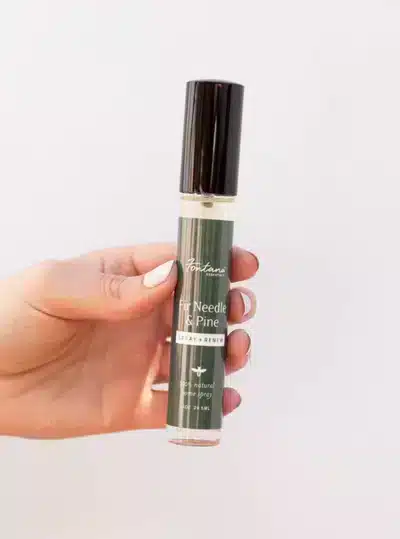
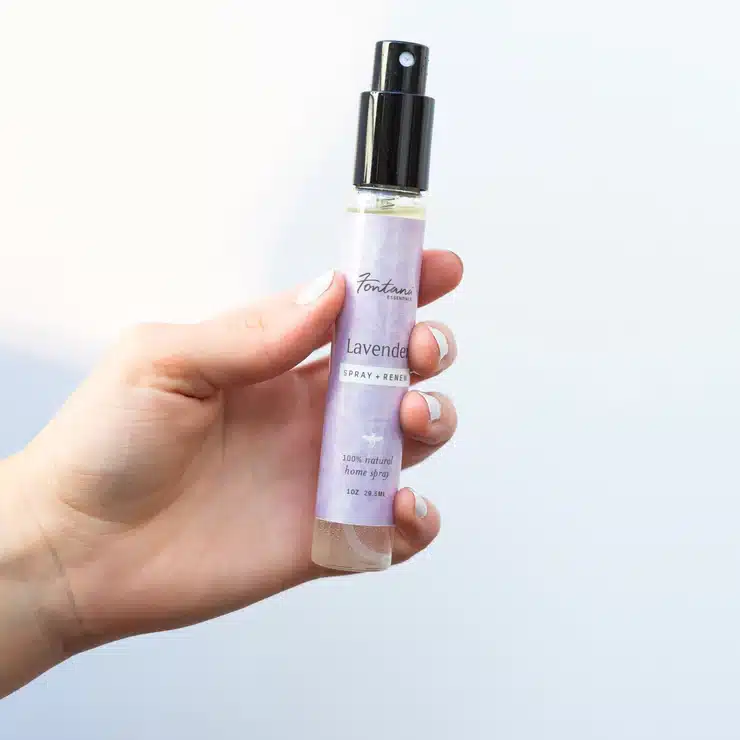
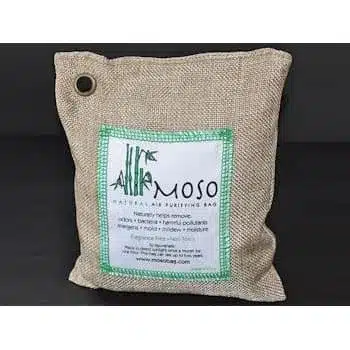
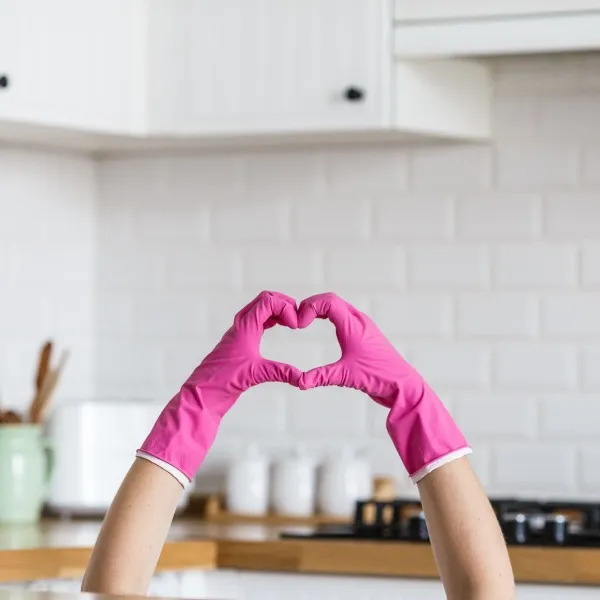
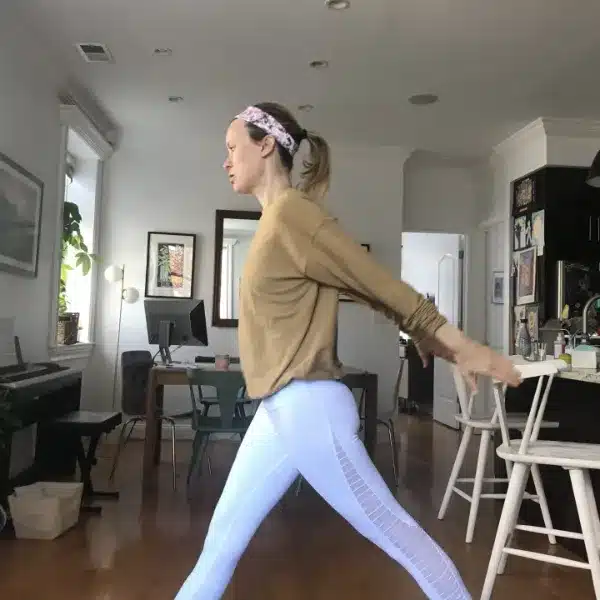
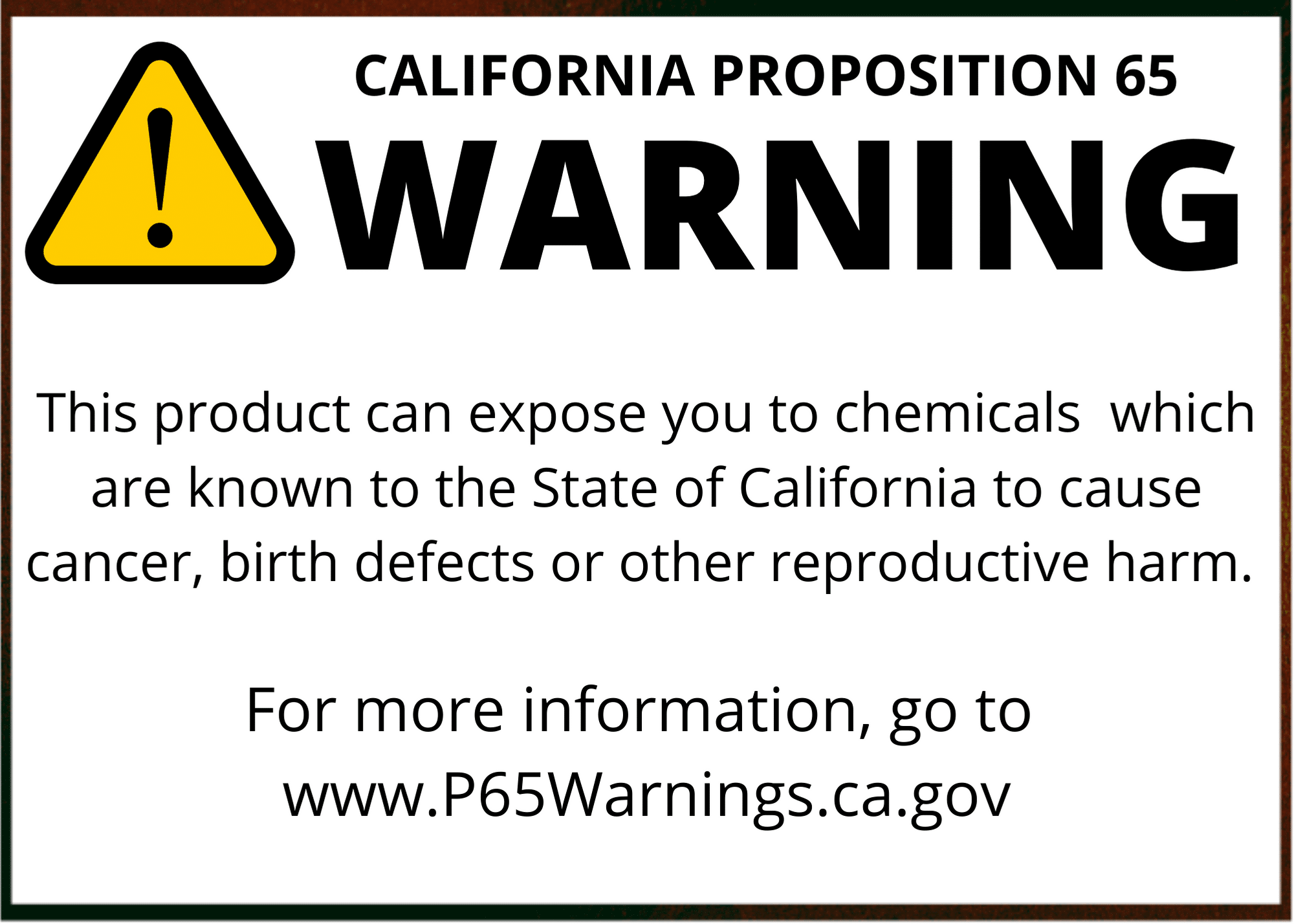
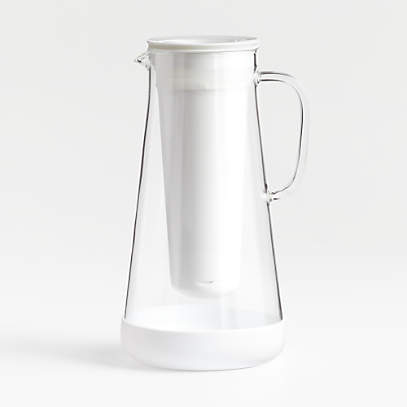
Leave a Reply
You must be logged in to post a comment.